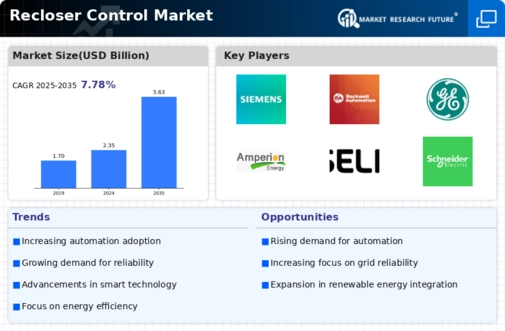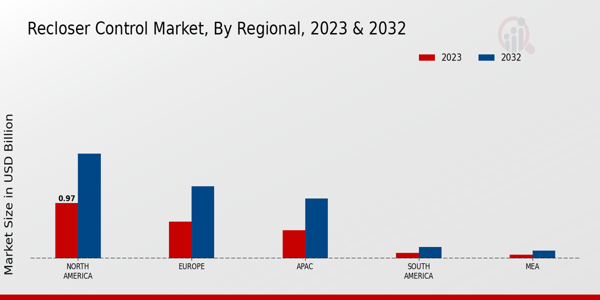Market Growth Projections
The Global Recloser Control Market Industry is projected to experience substantial growth over the next decade. With an expected market value of 2.35 USD Billion in 2024, the industry is anticipated to expand significantly, reaching 5.63 USD Billion by 2035. This growth reflects a compound annual growth rate of 8.28% from 2025 to 2035, driven by factors such as technological advancements, regulatory support, and increasing demand for grid reliability. The market's trajectory indicates a robust response to the evolving needs of electrical utilities worldwide, emphasizing the importance of recloser control systems in modern grid management.
Growing Demand for Smart Grids
The increasing global emphasis on smart grid technology is a primary driver for the Global Recloser Control Market Industry. Smart grids enhance the efficiency and reliability of electricity distribution, necessitating advanced recloser control systems. As utilities transition to smart grids, the demand for automated reclosers is expected to rise significantly. In 2024, the market is projected to reach 2.35 USD Billion, reflecting a growing recognition of the need for intelligent infrastructure. This trend is likely to continue, with the market anticipated to expand as utilities invest in modernizing their grid systems to improve service delivery and reduce outages.
Rising Investment in Renewable Energy
The shift towards renewable energy sources is reshaping the landscape of the Global Recloser Control Market Industry. As countries strive to meet sustainability goals, the integration of renewable energy into existing grids becomes crucial. Reclosers play a vital role in managing the intermittent nature of renewable sources like wind and solar. This integration requires advanced control systems to ensure grid stability. The market is expected to grow as utilities invest in recloser technologies that can accommodate the fluctuations associated with renewable energy generation, thereby enhancing overall grid reliability.
Regulatory Support for Grid Modernization
Government regulations aimed at modernizing electrical grids are significantly influencing the Global Recloser Control Market Industry. Many countries are implementing policies that encourage the adoption of advanced technologies to improve grid resilience and reliability. These regulations often mandate the use of automated systems, including reclosers, to minimize outages and enhance service quality. As a result, utilities are likely to increase their investments in recloser control systems, contributing to market growth. The anticipated CAGR of 8.28% from 2025 to 2035 underscores the potential for expansion driven by regulatory frameworks.
Technological Advancements in Control Systems
Technological innovations in recloser control systems are propelling the Global Recloser Control Market Industry forward. Advances in communication technologies, such as IoT and AI, enable more sophisticated monitoring and control of reclosers, enhancing their performance and reliability. These advancements allow for real-time data analysis and remote operation, which are essential for modern grid management. As utilities adopt these cutting-edge technologies, the market is expected to see substantial growth. The projected increase from 2.35 USD Billion in 2024 to 5.63 USD Billion by 2035 indicates a robust demand for technologically advanced recloser systems.
Increased Focus on Grid Reliability and Resilience
The growing focus on grid reliability and resilience is a critical driver for the Global Recloser Control Market Industry. Utilities are increasingly prioritizing the need to maintain continuous service amid rising demand and extreme weather events. Reclosers are essential components in achieving this reliability, as they help isolate faults and restore service quickly. The emphasis on enhancing grid resilience is likely to lead to increased investments in recloser technologies. This trend is expected to contribute to the market's growth trajectory, aligning with the overall objectives of modernizing electrical infrastructure.

























